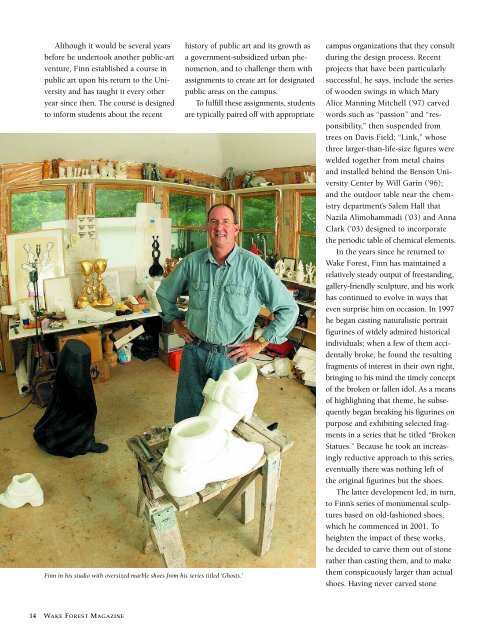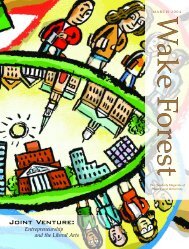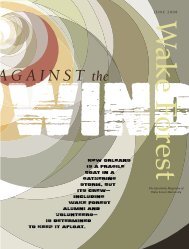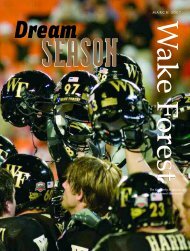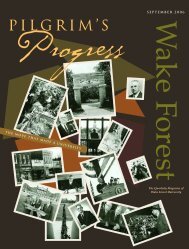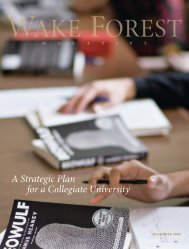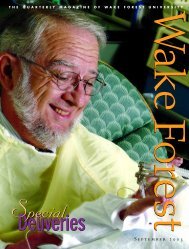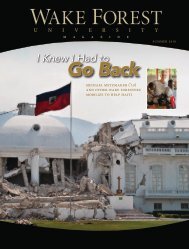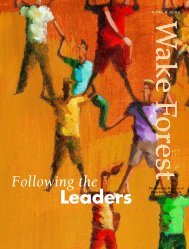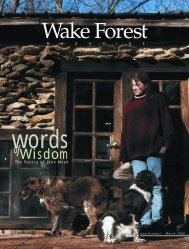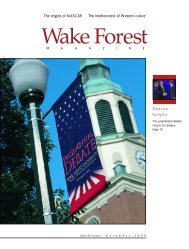Wake Forest Magazine, December 2004 - Past Issues - Wake Forest ...
Wake Forest Magazine, December 2004 - Past Issues - Wake Forest ...
Wake Forest Magazine, December 2004 - Past Issues - Wake Forest ...
Create successful ePaper yourself
Turn your PDF publications into a flip-book with our unique Google optimized e-Paper software.
Although it would be several years<br />
before he undertook another public-art<br />
venture, Finn established a course in<br />
public art upon his return to the University<br />
and has taught it every other<br />
year since then. The course is designed<br />
to inform students about the recent<br />
Finn in his studio with oversized marble shoes from his series titled ‘Ghosts.’<br />
14 WAKE FOREST MAGAZINE<br />
history of public art and its growth as<br />
a government-subsidized urban phenomenon,<br />
and to challenge them with<br />
assignments to create art for designated<br />
public areas on the campus.<br />
To fulfill these assignments, students<br />
are typically paired off with appropriate<br />
campus organizations that they consult<br />
during the design process. Recent<br />
projects that have been particularly<br />
successful, he says, include the series<br />
of wooden swings in which Mary<br />
Alice Manning Mitchell (’97) carved<br />
words such as “passion” and “responsibility,”<br />
then suspended from<br />
trees on Davis Field; “Link,” whose<br />
three larger-than-life-size figures were<br />
welded together from metal chains<br />
and installed behind the Benson University<br />
Center by Will Garin (’96);<br />
and the outdoor table near the chemistry<br />
department’s Salem Hall that<br />
Nazila Alimohammadi (’03) and Anna<br />
Clark (’03) designed to incorporate<br />
the periodic table of chemical elements.<br />
In the years since he returned to<br />
<strong>Wake</strong> <strong>Forest</strong>, Finn has maintained a<br />
relatively steady output of freestanding,<br />
gallery-friendly sculpture, and his work<br />
has continued to evolve in ways that<br />
even surprise him on occasion. In 1997<br />
he began casting naturalistic portrait<br />
figurines of widely admired historical<br />
individuals; when a few of them accidentally<br />
broke, he found the resulting<br />
fragments of interest in their own right,<br />
bringing to his mind the timely concept<br />
of the broken or fallen idol. As a means<br />
of highlighting that theme, he subsequently<br />
began breaking his figurines on<br />
purpose and exhibiting selected fragments<br />
in a series that he titled “Broken<br />
Statues.” Because he took an increasingly<br />
reductive approach to this series,<br />
eventually there was nothing left of<br />
the original figurines but the shoes.<br />
The latter development led, in turn,<br />
to Finn’s series of monumental sculptures<br />
based on old-fashioned shoes,<br />
which he commenced in 2001. To<br />
heighten the impact of these works,<br />
he decided to carve them out of stone<br />
rather than casting them, and to make<br />
them conspicuously larger than actual<br />
shoes. Having never carved stone


